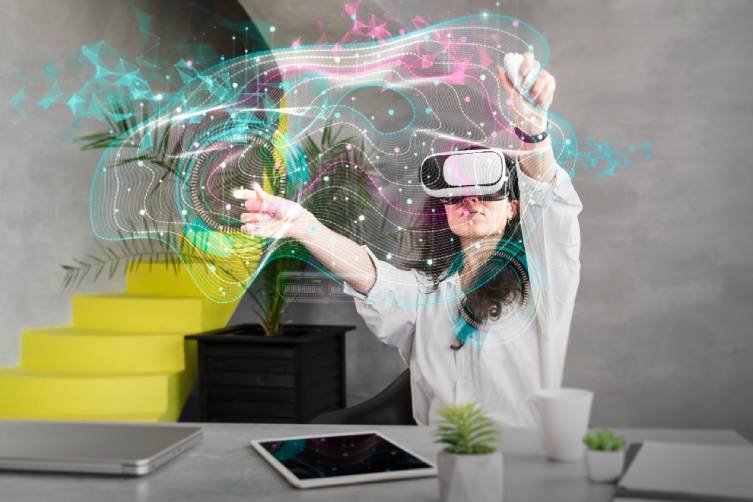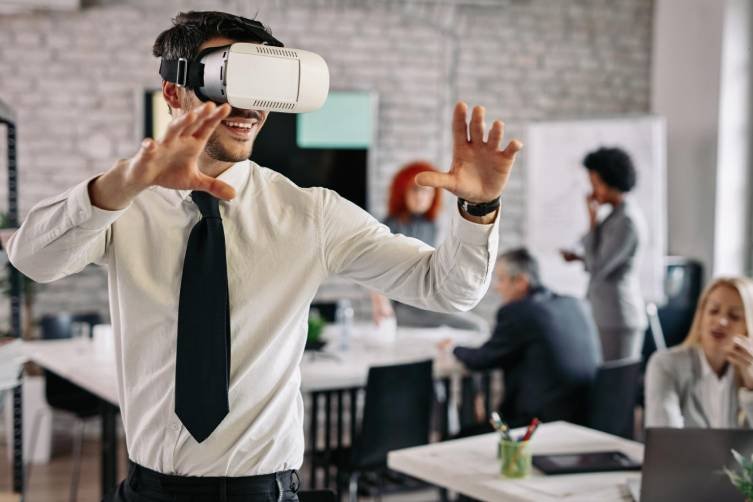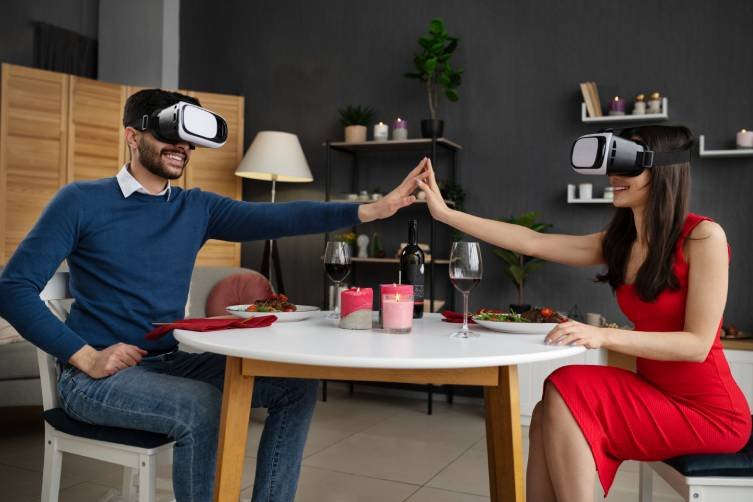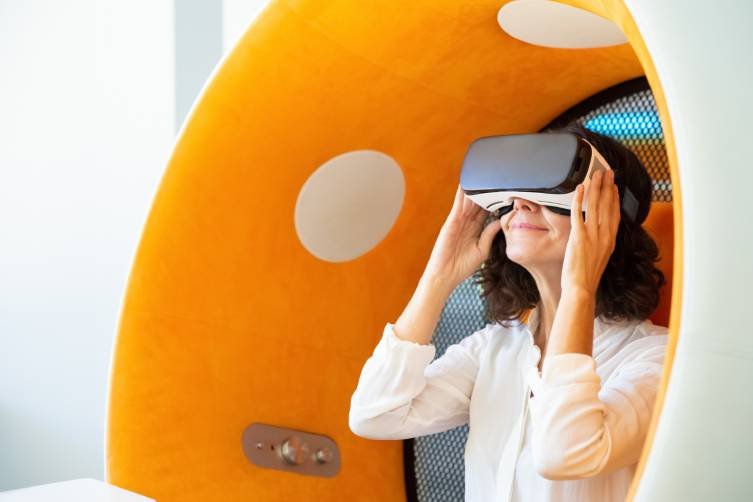
Inicio » Virtual Reality » Virtual Reality Marketing: How to Leverage Technology to Boost Your Business
Virtual Reality Marketing: How to Leverage Technology to Boost Your Business
Share note:
Virtual reality marketing is an innovative technique that uses technology to create immersive experiences for consumers. Virtual reality allows companies to offer consumers a unique and memorable experience, which can increase customer loyalty and sales. In addition, virtual reality marketing allows companies to reach a wider and more diverse audience, which can increase their reach and customer base.
Companies can use virtual reality to create unique brand experiences that allow consumers to interact with their products and services in a more meaningful way. For example, a fashion company could create a virtual reality experience that allows consumers to see how their clothes would look in different situations and environments. In this way, consumers can get a clearer idea of how the garments would look in real life and be more confident in their purchase.
Overall, virtual reality marketing is an exciting and effective technique that can help companies attract new customers and increase the loyalty of existing customers. By using technology to create immersive and unique experiences, companies can differentiate themselves from the competition and increase their reach and customer base.

Technology and Virtual Reality
Virtual reality (VR) technology is a tool that immerses users in a three-dimensional virtual interactive environment, usually through a headset and special glasses, to simulate a real-life experience. VR has become a popular tool in marketing, as it allows consumers to experience a company’s products and services first-hand. In this section, we explore the technical aspects of VR and how it is applied in marketing.
Hardware and Software
VR requires specialized hardware to function properly. Popular VR headsets include Oculus Quest 2, HTC Vive, and PlayStation VR. These devices connect to a computer or gaming console and use sensors and cameras to track the user’s movements and create an immersive VR experience. In addition, VR also requires specialized software to run, such as Unity, Unreal Engine, and Meta.
Augmented Reality Vs. Virtual Reality
Although often confused, augmented reality (AR) and virtual reality (VR) are different technologies. AR adds digital elements to physical reality, while VR creates a completely digital environment. AR is often used in print and online advertising, while VR is used to create immersive experiences. Both technologies have unique applications in marketing.
Learn more about augmented reality.
Emerging Technologies
VR is just one of many emerging technologies that are changing the way companies do marketing. Other technologies include mixed reality (MR), which combines elements of AR and VR, and emerging digital technologies such as 5G and artificial intelligence (AI). These emerging technologies have the potential to change the way companies interact with consumers and promote their products and services.

Marketing and Virtual Reality
Virtual Reality (VR) has become an increasingly popular tool in the marketing world. Brands and advertisers have embraced this technology to deliver immersive experiences to consumers and improve the effectiveness of their advertising campaigns. This section will explore virtual reality marketing strategies, the adoption of the technology in marketing and some examples of successful campaigns.
Marketing Strategy
The use of virtual reality in marketing allows brands to create unique and memorable experiences for consumers. VR can be used to enhance brand messaging, increase interaction with products and improve the effectiveness of advertising campaigns. An effective virtual reality marketing strategy must take into account the campaign objectives and target audience, and design an experience that is relevant and engaging for them.
Adoption of Virtual Reality in Marketing
The adoption of virtual reality technology in marketing has been gradual but steady. Industry-leading brands such as Gucci, Adidas, Volvo, Ikea, Dior, HBO and Sephora have used VR in their advertising campaigns to create immersive experiences and increase interaction with products. VR technology has also been adopted by media outlets, such as The New York Times, to deliver interactive content and immersive news experiences.
The adoption of VR in marketing is also influenced by the age of consumers. Young people are more likely to use VR technology and expect innovative and exciting experiences from brands. Brands looking to appeal to younger consumers should consider adopting VR in their advertising campaigns.
Virtual Reality Marketing Examples
Here are some examples of successful virtual reality marketing campaigns:
- Gucci used VR to create an immersive experience in its Milan store. Customers could use VR glasses to explore the creative process behind the brand’s fashion collection and view the designs in 3D.
- Adidas used VR to create an immersive experience in its New York store. Customers could use VR glasses to see how the brand’s shoes were made and customize their own design.
- Volvo used VR to create an immersive experience at its booth at the Geneva Motor Show. Visitors could use VR goggles to explore the interior of the brand’s new model and experience autonomous driving.
These examples demonstrate how VR can be used to enhance the consumer experience and increase the effectiveness of advertising campaigns.
The adoption of VR in marketing is also influenced by the age of consumers. Young people are more likely to use VR technology and expect innovative and exciting experiences from brands. Brands looking to appeal to younger consumers should consider adopting VR in their advertising campaigns.

Interaction and Engagement
Virtual reality (VR) is a technology that has proven to be very effective in increasing audience engagement and interaction with brands. Here are some strategies that can help companies make the most of this technology to achieve a greater presence in social networks, gamification and an immersive experience.
Presence in Social Networks
Virtual reality offers a unique opportunity for brands to connect with their audience on social media. Platforms such as Instagram and Snapchat have been pioneers in integrating virtual reality into their apps, allowing companies to create immersive experiences and share interactive content with their audience.
In addition, virtual reality also allows companies to create exclusive content for their social media followers, which can increase audience engagement and loyalty.
Gamification
Gamification is another effective strategy to increase audience engagement and interaction with brands. Virtual reality offers an ideal platform for gamification, as it allows companies to create interactive and realistic experiences that engage the user in a unique way.
Companies can use virtual reality to create games and challenges that engage consumers and encourage them to interact with the brand. This can help increase audience engagement and loyalty, as well as improve brand perception.
Immersive Experience
The immersive experience is one of the main benefits of virtual reality. Technology allows users to immerse themselves in virtual worlds and experience situations that would otherwise be impossible.
Companies can use this technology to create immersive experiences that help consumers interact with the brand in a deeper and more meaningful way. For example, a tourism company could use virtual reality to create an immersive experience that allows users to explore a tourist destination before booking a trip.
In short, virtual reality offers a unique opportunity for companies to increase public engagement and interaction with their brands. By using strategies such as social media presence, gamification and immersive experience, companies can create interactive and realistic experiences that help improve brand awareness and consumer loyalty.
Companies can use virtual reality to create games and challenges that engage consumers and encourage them to interact with the brand. This can help increase audience engagement and loyalty, as well as improve brand perception.

Virtual Reality Applications
Virtual Reality (VR) has been a constantly evolving technology that has become a valuable tool for various industries. The following are some of the most common applications of Virtual Reality.
Virtual Reality in Retail
Virtual Reality in Retail allows customers to experience a unique and personalized shopping experience. Products can be visualized in 3D and customers can interact with them before making a purchase. This can increase sales and customer satisfaction, as they can see how the products will look in their home before they buy them. Major retailers such as Walmart and Ikea have used Virtual Reality to enhance their customers’ shopping experience.
Virtual Reality in Education
Virtual Reality in Education allows students to have an immersive and personalized learning experience. Students can interact with objects and situations in 3D, allowing them to experience situations they would not otherwise be able to. This can increase training efficiency and improve information retention. Large companies such as Marriott have used Virtual Reality to train their staff more effectively.
Virtual Reality in Tourism and Entertainment
Virtual Reality in Tourism and Entertainment allows users to experience tourist destinations and entertainment activities in a completely new way. Users can visit tourist destinations, museums and theme parks in 3D, allowing them to experience the feeling of being there without having to travel. This can increase customer satisfaction and tourism promotion. Large companies such as Disney have used Virtual Reality to enhance the experience of visitors to their theme parks.
In summary, Virtual Reality has applications in a variety of industries, such as Retail, Education and Tourism and Entertainment. Virtual Reality can enhance customer experience, increase sales, improve training efficiency and improve tourism promotion. Large companies such as Walmart, Ikea, Marriott and Disney have used Virtual Reality to improve their business.

The Future of Virtual Reality
Virtual reality (VR) has undergone a rapid evolution in recent years. Technology has advanced significantly and has allowed VR to become an increasingly accessible and attractive tool for marketers. In this sense, the future of VR is promising, and it is expected to continue to grow and expand in the coming years.
Innovations and Advances
VR is constantly evolving, and is expected to continue to advance in the future. One of the most exciting innovations is the ability to use VR to create immersive experiences that engage consumers in a deeper way. For example, movie companies can use VR to create experiences that allow viewers to feel like they are inside the movie. In this way, VR can be used to create unique and exciting experiences that appeal to audiences of all ages.
Another interesting innovation is the possibility of using VR to create fashion experiences. Companies can use VR to create virtual fashion shows that allow consumers to experience clothing more realistically. In this way, VR can be used to create unique and exciting shopping experiences that engage consumers and allow them to interact with products in a more meaningful way.
Market and Size
The VR market is steadily growing, and is expected to continue to grow in the coming years. According to a New York Times report, the VR market is expected to reach $70 billion by 2027. This is largely due to the increased demand for immersive experiences and the growing accessibility of technology.
Retention and Data
Retention is a key factor in the success of VR in marketing. Companies must ensure that the VR experiences they create are interesting and engaging enough to keep consumers engaged. In addition, it is important for companies to collect data on how consumers interact with VR in order to improve and optimize experiences in the future.
In conclusion, the future of VR in marketing is promising. Innovations and technological advances are allowing VR to become an increasingly accessible and attractive tool for marketers. The VR market is steadily growing, and is expected to continue to grow in the coming years. Retention and data collection are key factors in the success of VR in marketing, and companies must ensure that they create interesting and engaging experiences that engage consumers in a deeper way.
What are the benefits of using virtual reality in a marketing strategy?
Virtual reality (VR) offers an immersive and unique experience for consumers, which can increase interaction and engagement with a brand. In addition, VR allows companies to showcase their products or services in a more realistic and detailed way, which can help consumers make more informed purchasing decisions.
How can companies use virtual reality to enhance the customer experience?
Companies can use virtual reality to offer customers a unique and memorable brand experience. For example, a travel company can use VR to allow customers to virtually experience a destination before booking a trip. In this way, customers can have a more realistic idea of what to expect and make more informed purchasing decisions.
Which companies are using virtual reality in their marketing campaigns?
Many companies are using virtual reality in their marketing campaigns. For example, the Audi car brand has used VR to allow customers to virtually experience driving its vehicles. Other brands, such as Coca-Cola and McDonald’s, have used VR to create unique and memorable brand experiences.
How can the results of a marketing campaign be measured using virtual reality?
The results of a marketing campaign using virtual reality can be measured in a number of ways, such as consumer interaction rate, the amount of time consumers spend interacting with the VR experience, and consumer conversion rate. In addition, companies can use surveys and data analysis to evaluate the effectiveness of the campaign.
What types of products can best be promoted using virtual reality?
Virtual reality can be used to promote a wide variety of products and services. For example, VR can be used to allow consumers to virtually experience a product before purchasing it, as in the case of beauty products or home furnishings. It can also be used to promote experiences, such as travel or events.
How can virtual reality be integrated into an omnichannel marketing strategy?
Virtual reality can be integrated into an omnichannel marketing strategy in a number of ways. For example, a company can use VR in a physical store to allow customers to virtually experience products before purchasing them. It can also be used in an online store to allow customers to virtually experience products before purchasing them. In addition, VR can be used at branded events to create unique and memorable experiences for consumers.
Would you like to apply Virtual Reality in your marketing projects? At Virtual Arena we are specialists in VR consulting and development for companies and institutions.
Recent articles

3D Animation: Current Trends and Innovations

Services marketing: Effective strategies for customer loyalty

3D Hologram What is it and what are its applications?
Do you have a project in mind?
Related articles




